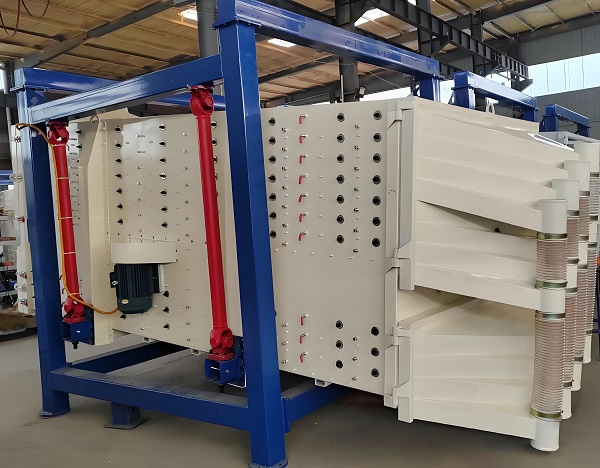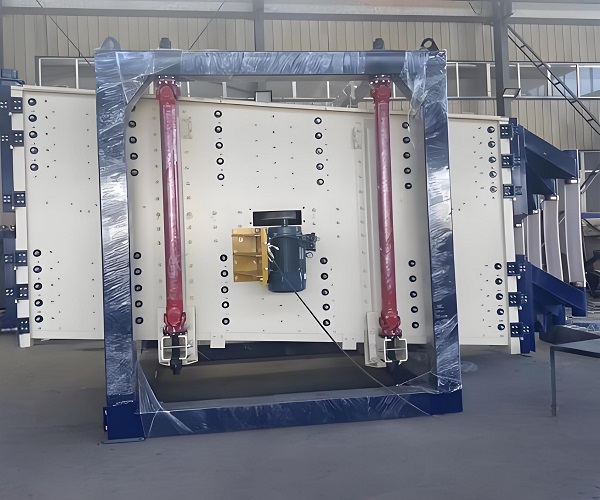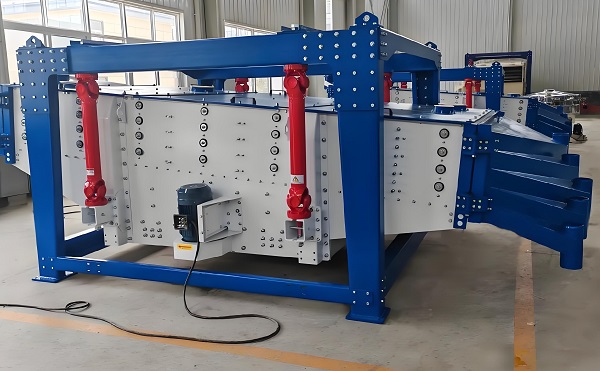With the increasing demands for screening accuracy and efficiency in modern industrial production, traditional vibrating screens are gradually becoming insufficient to meet the requirements of certain working conditions that demand high precision in material grading, impurity removal, and screening. Therefore, a device designed based on the principle of manual screening—the tumbler screen—has emerged. With its gentle screening motion, high-efficiency grading capability, and low equipment wear, the tumbler screen has become one of the important screening devices in the chemical, food, pharmaceutical, metallurgical, new materials, grain, and environmental protection industries. This article will systematically analyze the structural composition, working principle, main structural advantages, and performance characteristics of the tumbler screen.

A. Working Principle and Structural Composition of the Tumbler Screen
1. Working Principle
The design concept of the tumbler screen originates from the "reciprocating circular shaking" motion of manual screening. Its core is to use an eccentric drive system to generate a three-dimensional elliptical trajectory motion of the screen body:
Horizontal circular motion;
Vertical periodic slight throwing motion;
The material spirals outward on the screen surface, achieving stratification and screening.
This motion mode allows materials to remain on the screen surface for a longer time, resulting in a longer screening path and achieving a "gentle, precise, and efficient" grading effect. It is especially suitable for fine powders, easily clogged screens, lightweight materials, or fragile materials.
2. Structural Composition
A typical gyratory screen mainly consists of the following parts:
(1) Screen Box (Screen Body)
The screen box is the main working part of the machine, composed of upper and lower multi-layer screen frames, screen frame sealing devices, and clamping devices. Each layer of screen can be made of different materials such as stainless steel mesh, nylon mesh, or woven wire mesh, selected according to the material characteristics and screening accuracy.
(2) Drive System
The drive system consists of a motor, belt drive mechanism, eccentric wheel, and linkage mechanism. The motor drives the eccentric shaft to rotate via the belt pulley, causing the screen body to produce an elliptical gyratory motion. Some high-end equipment uses adjustable eccentric blocks or a frequency conversion drive system, which can flexibly adjust the amplitude, speed, and motion trajectory.

(3) Support and Vibration Damping Devices
The screen body is connected to the frame via flexible vibration damping devices (such as rubber springs, silicone pads, or air springs), effectively reducing vibration transmission, noise, and equipment wear, and improving stability.
(4) Sealing and Dustproof System
The gyratory screen typically adopts a fully enclosed design. The screen cover is equipped with quick-locking buckles and sealing rings, enabling clean production without dust spillage, making it particularly suitable for the food and pharmaceutical industries.
(5) Screen Cleaning System
To address the problem of screen clogging caused by fine powder materials, the gyratory screen is equipped with various screen cleaning devices, such as bouncing balls, ultrasonic screen cleaning, and brush screen cleaning, ensuring stable screening over long periods.
(6) Discharge System
The oversize and undersize materials are discharged from the respective discharge ports, and the discharge port angle can be flexibly adjusted to adapt to different production layouts.
B. Structural Advantages of the Gyratory Screen

1. Simulates Manual Screening Motion, High Screening Accuracy
The movement trajectory of the gyratory screen is similar to the "circular + light tossing" motion of manual screening. 1. **Slow Rolling, Layering, and Passing Through the Screen:** The material slowly rolls, layers, and passes through the screen on the screen surface, extending the screening time and giving particles more opportunities to contact the screen mesh, thus achieving extremely high grading accuracy. In practical use, its screening accuracy can reach 1.5 to 5 times that of ordinary vibrating screens, making it particularly suitable for screening ultrafine powders above 200 mesh.
2. High Screen Surface Utilization and Large Processing Capacity:** Due to the three-dimensional motion of the screen body, the material is evenly distributed along the screen surface and forms a spiral outward diffusion motion, ensuring that almost the entire screen surface is fully utilized. Combined with a multi-layered structure, multi-stage screening and high-throughput production can be achieved. Compared to vibrating screens of the same specifications, the processing capacity of a gyratory screen can be increased by 30% to 60%.
3. Minimal Material Damage and Wide Applicability:** The gyratory screen's movement is gentle and without high-frequency vibration, posing no risk of breakage to fragile materials (such as medicinal herb granules, tea leaves, and microplastics). It has a wide range of applications, covering powders, granules, flakes, and spherical materials, and is especially suitable for screening materials with low specific gravity, strong electrostatic properties, high adhesion, or those prone to screen clogging.
4. Low Noise, Long Lifespan, and Stable Operation
Due to its eccentric flexible drive, the gyratory screen exhibits low vibration amplitude and minimal mechanical impact. Combined with high-quality rubber vibration damping devices, the overall noise level is below 75dB, making it suitable for continuous operation. Key components utilize high-strength steel and laser-cut welding technology, resulting in a robust structure and a service life typically 2-3 times longer than traditional vibrating screens.
5. Modular Structure Design for Convenient Disassembly and Maintenance
Screen replacement utilizes a quick-locking device, requiring no tools. The screen frame, cover plate, and discharge port are all modularly designed, facilitating adjustments to the number of layers and the discharge direction. For enterprises producing multiple varieties in small batches, this allows for rapid product switching, enhancing production flexibility.

6. Diverse Screen Cleaning Systems for Significant Anti-Clogging Effect
Different screen cleaning systems can be configured for different material characteristics. For example:
Bouncing ball screen cleaning: suitable for ordinary powders;
Ultrasonic screen cleaning: suitable for ultrafine powders (such as quartz powder, carbon powder, etc.);
Brush screen cleaning: suitable for lightweight or fibrous materials.
These screen cleaning devices effectively prevent clogging, improve screen permeability, and ensure stable operation over long periods.
7. Enclosed and environmentally friendly design, meeting clean production requirements: The fully sealed structure prevents dust from escaping. The discharge port can be connected to a negative pressure or dust collection system to achieve dust-free operation, particularly meeting the cleanroom standards such as GMP and HACCP in the food, pharmaceutical, and chemical industries.
8. Highly adjustable parameters, adaptable to various working conditions: By adjusting the eccentric wheel angle, screen inclination angle, rotation speed, and material stroke, operators can flexibly control the material's movement trajectory and residence time on the screen surface, thus balancing throughput and screening accuracy to meet screening requirements under various working conditions.
C. Performance characteristics and application advantages

1. Balance between high efficiency and low energy consumption: The gyratory screen, through optimized mechanical design, achieves a large screening area movement with lower power. Its energy consumption is only 60%–70% of that of a vibrating screen with the same capacity, significantly reducing operating costs.
2. Multi-layer Screening, Multi-purpose Function: Common gyratory screens can be configured with 1-5 layers of screens to achieve 2-6 levels of particle size classification. They can simultaneously perform coarse screening, fine screening, and impurity removal, reducing the number of devices and floor space required.
3. Automation and Intelligentization Trends: Modern gyratory screens are increasingly incorporating intelligent control systems. Through frequency conversion speed regulation, motor monitoring, automatic lubrication, and fault alarm functions, they achieve unattended operation. This trend significantly improves the automation level and safety of production lines.
4. Typical Application Areas:
Chemical Industry: Resin powder, pigments, calcium carbonate, quartz sand, PVC, polyethylene powder, etc.;
Food Industry: Flour, starch, milk powder, coffee powder, sugar powder, spices, etc.;
Pharmaceutical Industry: Screening of raw materials for traditional Chinese medicine powders, granules, and tablets;
Metals and Minerals: Metal powders, alumina, graphite, ceramic powder, etc.;
New Materials: Battery positive and negative electrode materials, magnetic powders, nanomaterials, etc.

The wide range of applications fully demonstrates the unique position of gyratory screens in modern industrial screening equipment.
Overall, the gyratory screen, with its unique manual sieving principle, gentle yet efficient motion, superior structural design, and excellent operational stability, has become an important piece of equipment for high-precision material screening. Compared to traditional vibrating screens, it not only significantly improves screening accuracy and capacity but also effectively reduces noise, energy consumption, and maintenance costs, meeting the requirements of modern industry for energy-saving, high-efficiency, environmentally friendly, and intelligent production.
With the development of intelligent manufacturing and automation technologies, the gyratory screen will continue to innovate in areas such as control system optimization, lightweight structure, screen material upgrades, and remote monitoring, further expanding its application prospects in powder engineering and particle classification.
Save Time! Get A Detailed Quotation Quickly.
